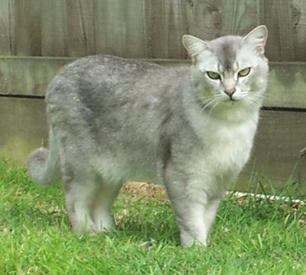
In 1981, the unplanned mating of a Chinchilla Persian and a lilac Burmese resulted in the creation of a new breed. The Burmilla was considered very handsome in appearance, and many enthusiasts wanted to develop the breed in the United Kingdom for future generations. A member of the Asian breed group, the Burmilla achieved championship status in the 1990s and became a highly sought domestic cat, despite being relatively hard to come by. The Burmilla is the most recent breed to be added to the Cat Fancier’s Association registry, having only evolved some 30 years ago.
The Burmilla is observed with a long or short length coat, usually with feathering on the underside, front and tail. It is further characterised by a slender build, long, nimble legs, triangular ears, a tapering tail, large, expressive eyes and a short muzzle. The coat is typically semi-longhaired, and should not require too frequent grooming, although a weekly brush is necessary to smooth out tangles and mattes coming into winter. A variety of coat colours are observed in the breed, including black, chocolate brown, blue, lilac, red, tortoiseshell and cream. A distinctive black line surrounds the eyes, nose and lips, which many people describe as looking like make-up.
Owners, breeders and enthusiasts have described the Burmilla as possessing a balanced temperament, behaving with gentleness, affection and loyalty. The Burmilla is both an independent and sociable breed, enjoying a free roam alone and plenty of interaction with its human family. For this reason, the Burmilla is well suited to indoor or outdoor living, although many owners prefer to keep their cat indoors due to the relative rarity of the breed. A fully-grown Burmilla will weigh between 8-10 pounds, with discrepancies across gender. The average life expectancy of a Burmilla is 15 years of age, although it is not uncommon for the breed to outlive this expectancy.
The Burmilla is a healthy and resilient breed with very few documented cases of affliction or disease. These range from mild allergies to more serious cases of polycystic kidney disease, which will require veterinary intervention.
Do you own a Burmilla? Let others know what they're like!
Related products
Advantage 80 Spot On Flea Control Large Cats and Rabbits
from £12.95
Advantage 40 Spot On Flea Control Cats, Small Dogs and Rabbits
from £12.95
Advantage 250 Spot On Flea Control Large Dog
from £12.95
Advantage 100 Spot On Flea Control Medium Dog
from £12.95
Drontal Tasty Bone Wormer Tablets for Small & Medium Dogs (2 to 20kg)
from £2.15
TermaWorm™ Tablets for Cats & Dogs
from £1.79
Drontal Tasty Bone XL Wormer Tablets for Large Dogs (Over 20kg)
from £6.39
Advantage 400 Spot On Flea Control Extra Large Dog
from £12.95